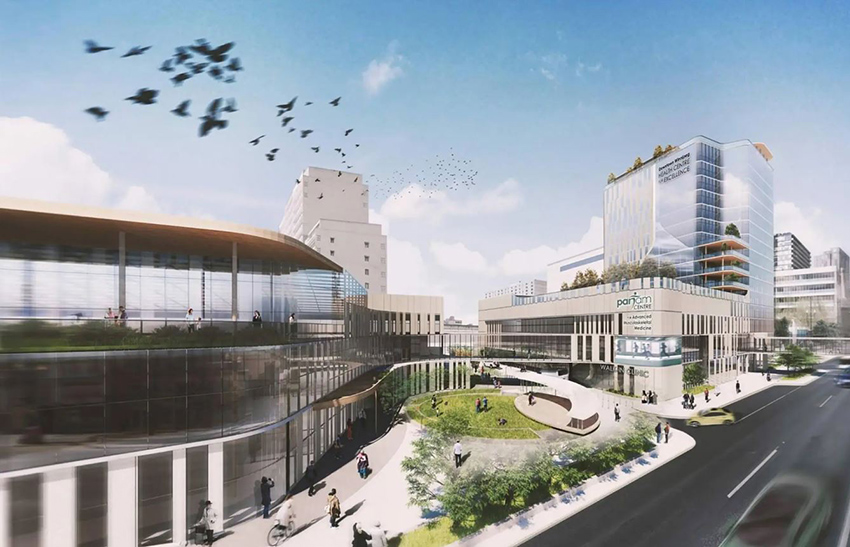By Brent Bellamy, Architect + Creative Director
Originally published in the Winnipeg Free Press
From Rosser Avenue in Brandon to Yonge Street in Toronto, Canadian cities of every shape and size built a downtown indoor shopping mall in the 1980s. These developments were a last desperate salvo in the battle between traditional main street retail and the new suburban shopping mall.
Image: A 2023 architectural rendering of a revitalized Portage Place. The anchor use for the redevelopment will be the Downtown Winnipeg Health Centre for Excellence, including a new tower with a range of medical facilities and services. (Architecture49)
In Winnipeg, the mall that was going to save downtown was called Portage Place. It opened to great fanfare in 1987 and connected two of the country’s largest urban department store buildings, Eaton’s and The Bay. As in most other cities, Portage Place soon began a long, slow march of decline, as it became clear that downtown could never out-suburb the suburbs.
More than 30 years later, long after Eaton’s had been replaced with an arena, a global pandemic put the final nails in the coffin for Portage Place and The Bay. Downtown Winnipeg faced the prospect of having nearly two million square feet of darkness, along four blocks of its primary street. It was a situation that would have devastating impacts on the health of Winnipeg’s entire downtown, damaging the city’s image, and its ability to compete for business investment, tourism, and immigration.
In other cities, the answer might have been as simple as a national REIT coming in to build gleaming office or condo towers, but in Winnipeg, development at this scale in downtown must intimately link economic success with social investment. Southern Chiefs’ Organization has stepped forward to create a visionary new future for The Bay, and the development arm of True North Sports and Entertainment has taken on the challenge of formulating a plan for Portage Place.
Each group, with a deep understanding of community needs, has taken a redevelopment play and turned it into a social development plan that not only supports the individual projects but creates lasting change across downtown and beyond.
The key to success for Portage Place will be municipal, provincial, federal, and Indigenous governments, working together with private developers to leverage public investment in our community’s broader social objectives to underpin an economic return that makes the private development viable.
The failure of the original Portage Place was that it was pushing against a current of societal change as cities across the continent became more suburban. It overwhelmingly relied on drawing in people from across the city as a destination. True North’s plan hopes to find a successful balance between attracting transient visitors and supporting the local downtown community.
The anchor use for the redevelopment will be the Downtown Winnipeg Health Centre for Excellence, including a new tower with a range of medical facilities and services.
This use takes government health-care investment that is already promised to happen and leverages it to support urban renewal. As a sector that requires in-person work, medical sciences have proven to be immune to impacts of work-from-home, or retail trends.
It provides a long-term, stable tenant to support the private real-estate investment, and is guaranteed to consistently attract thousands of people to downtown every day. Creating hundreds of high-paying jobs in the city centre will also increase the number of people living downtown, with those wanting an urban lifestyle near their work supporting other market driven residential development.
Cities such as Austin, Texas, and Pittsburgh, Pa., serve as precedents for using the medical sector as a successful driver of downtown renewal. Connecting larger health-care centres with universities and private sector research, as well as complementary laboratory, pharmaceutical, and diagnostic services, has created technology hubs and inspired startup companies in new downtown innovation districts.
The Portage Place redevelopment hopes to translate the high number of visitors to the medical centre into a market for complementary amenities and services, like restaurants and retail. Adjacent buildings might also leverage this new foot traffic into storefront business, helping to add vibrancy to downtown sidewalks.
To help find the balance between servicing downtown visitors and supporting the local downtown community, True North envisions making strong physical and programmatic connections to the surrounding neighbourhood.
A new residential tower of affordable homes will anchor the west side of the campus, creating a strong synergy with Wehwehneh Bahgahkinahgohn, the skywalk connected redevelopment of The Bay building. The former mall space is envisioned to provide amenities and services that support local residents.
This includes a full-service grocery store and other community-oriented retail, newcomer services, wrap around and connected care medical services, daycare, drop-in centres and expanded recreational and social programing at the YMCA. Prairie Theatre Exchange will be retained as an important cultural amenity.
The fortress-like appearance of Portage Place will be dramatically broken down at Edmonton Street to create new public spaces and an outdoor pedestrian promenade that punches through the building to stitch the Central Park neighbourhood back into the fabric of downtown, with the former mall acting as its community hub.
It will be vital that the scheme breaks down the long building walls even further, making strong pedestrian connections to Portage Avenue. Functions like food service or retail located along the street, accessed from the sidewalk in a storefront configuration, would provide a high level of porosity along the building edge that creates pedestrian interest and connectivity.
Portage Place was supposed to save downtown. It didn’t, and it never will be the silver bullet solution it was promised to be, but we now have a second chance to do it differently.
With local developers working closely with the community and four levels of government, including Indigenous government, two million square feet of darkness might just become a shining light in the future of downtown Winnipeg.
Brent Bellamy is creative director at Number TEN Architectural Group.


